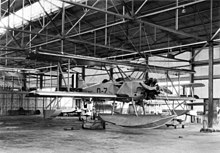| NB | |
|---|---|

| |
| Boeing NB-1 | |
| Role | Military trainer |
| Manufacturer | Boeing |
| First flight | 20 October 1923 |
| Number built | ca. 72 |
The Boeing NB (or Model 21) was a primary training aircraft developed for the United States Navy in 1923. It was a two-bay, equal-span biplane of conventional configuration with interchangeable wheeled and float undercarriage. The pilot and instructor sat in tandem, open cockpits.
The NBs were produced in two batches; the first (NB-1) were powered by radial engines and the second by war-surplus V-8s still in the Navy's inventory. The original prototype evaluated by the Navy had been assessed as being too easy to fly, and therefore of limited use as a trainer. In particular, it was noted that the aircraft was impossible to spin. The NB-1 design attempted to introduce some instability, but it was soon discovered that while it was now possible to get the aircraft into a spin, it was virtually impossible to recover from one. A series of modifications were made to attempt a compromise.

